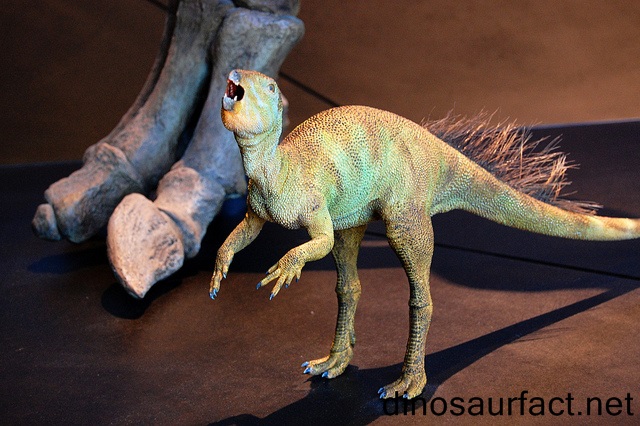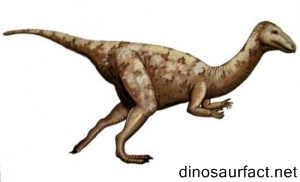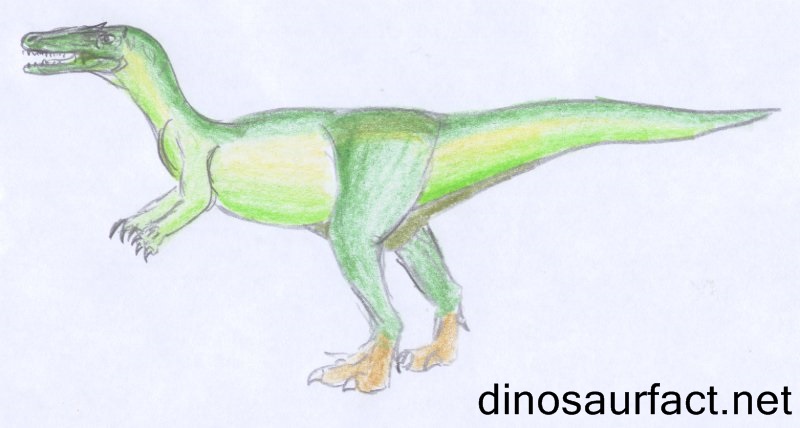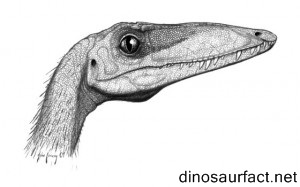 Click to visit the previous dinosaur bio
Click to visit the previous dinosaur bio
 |
|
 |
|
Kingdom: Animalia
Phylum: Chordata
Class: Reptilia
Superorder: Dinosauria
Order: Saurischia
Suborder: Theropoda
Family: Coelophysidae
Genus: Camposaurus
 |
|
 |
|
 |
|

The camposaurus is a carnivorous dinosaur, belonging to the theropod family. Owing to very little fossils of this dinosaur being found and identified for certain, a lot of aspects about this dinosaur remain obscure. The fossils supposedly belong to early to middle Norian age, making the Camposaurus possibly the oldest neotheropod dinosaur. It is related to the Coelophysis and Syntarsus dinosaurs.
The discovery of fossils and identification
Parts of the skeletal remains were found in the Late Triassic rock of Arizona. Only the lower limbs bones of the camposaurus dinosaurs have been identified. The specimen
- UCMP 34498 was discovered in the Bluewater creek formation of Arizona, in the Placerias quarry. Originally, the site was confused with a another more ancient member of the Mesa Redondo of the Chinle foundation, confusing the creature’s period of existence but paleontologist Bill Parker reported the correction. Owing to the fossils being found in present day Arizona, the scientific name of the camposaurus is C. arizonensis which was named in 1998.The fossils suggest the species were in existence 205 to 210 million years ago.
The species have so been named after Charles Lewis Camp, who took part in the 1930 excavations at the Placerias quarry and possibly was the discoverer of the holotype specimen that exists today. The name camposaurus is based on “Charles Camp’s Reptile” or “Charles Camp’s Lizard”. Charles Camp was born in Jamestown, North Dakota in 1893 and was interested in anatomy and paleontology since his early days and served as Director of Paleontology at the University of California, USA.
The late Triassic
The late Triassic is the final epoch of the entire 3 epochs from the Triassic period in the geological timeframe. A majority of dinosaurs are believed to have evolved during this period, including the Coelophysis and the Eorapter. It is followed by the lower Jurassic period. The Late Triassic is rich with dinosaur history and much of dinosaurs has been found from fossils that date back to this period.
The difference between neotheropods and theropods is that neotheropods have evolved to lose their fifth finger completely and have shrunk or diminished the use of the fourth. Toes, too comprise of only three digits – the other two digits shrunk inside the foot bone structure.
The Placerias quarry
The Placerias quarry is located in the Mesa Redondo member of the Chinle Formation, near Romero springs, Arizona. This site has reportedly yielded perhaps the most diverse range of Late Triassic continental vertebrate fossils. It is a collection of tetrapod bones on a floodplain in a high water table. Excavations in the quarry have led to more than 80 taxa of dinosaurs being identified by paleontologists Long and Murry.
Distinct anatomical features of the Camposaurus
Paleontologists Martin Ezcurra and Stephen Brusatte have studied what little bones there exist, to further examine the notable features of the camposaurus. Not a lot can be determined about the creature’s exact height or weight or their physical statistics as there is not much information to go by. However there are two distinct abnormalities that distinguish the Camposaurus from other related dinosaur species:
- A distinctive ridge on the tibia (one of the lower leg bones) where it meets the fibula, the medial surface having a strong bowing of the median plate at the tip of the snout and diagonal tuberosity
- Absence of a knob of bone on part of the ankle i.e. the talus bone is without a strong cranial projection of the median condoyle.
These features help distinguish and separate the Camposaurus from the closely related and anatomically similar Coelophysis. In fact, the Camposaurus were originally, incorrectly assumed to belong to the Coelophysis family until such was proven wrong by Ezcurra and Brusatte. Even so, the two genera are synonymous. The C. arizonensis is most closely related to the Megaopnosaurus rhodensis, another neotheropod.
Recent Studies
- In 2011, the fossils of the dinosaur were phylogenetic ally analyzed and found to be a close relative of Megaopnosaurus rhodesiensis.
- In 2007, C. arizonensis were assigned to the family Coelophysidae, thus putting an end to the debate over the Camposaurus’ classification and subsequent taxonomy.
Conclusions about the Camposaurus
Owing to a lack of fossil material, not much can be said about the Camposaurus. Many paleontologists doubt the validity of the camposaurus as a species. Being a neotheropod, it had four digits in the upper limbs and three-toed narrow feet. Although even the fact that the camposaurus is was probably a neotheropod, it is still questioned since there is lack of concrete evidence.
The Camposaurus is believed to be small and a carnivore. It consumed only meat as can be ascertained from its eating habits based on lower limb data. This implies that the creature preyed upon species smaller than itself or hunted bigger prey in packs, although the former is more plausible since there is no data to suggest whether or not they lived in packs. Although no actual data can be found pertaining to the creature’s height, the height is estimated to be about roughly 3 feet. The camposaurus was a ground dwelling animal.
Not much is known about the dinosaurs belonging to the Late Triassic period (except Coelophysis, remnants of which are well-preserved) owing to the large amount of erosion that has led to serious post mortem damage. The known bones are so rare and by themselves so indistinguishable that it is difficult to ascertain whether or not they should, in fact be used for analysis. In fact, many scientists and paleontologists do not recommend using these fossils as evidence since they claim this will only cause confusion and debate over this subject rather than help us find answers.
Studies about the Camposaurus could help determine and calibrate a lot of the early history of the evolution of neotheropod dinosaurs, such as their evolution and anatomy. Much about the dinosaur still remains pure conjecture. But such studies require the need for more fossils of pre-Late-Triassic dinosaurs. Until then, there is no unveiling the shroud of mystery from the other aspects of the Camposaurus.
Index
Extinct Profiles
 Triassic Dinosaurs
Triassic Dinosaurs Jurassic Dinosaurs
Jurassic Dinosaurs Cretaceous Dinosaurs
Cretaceous Dinosaurs Pterosaurs
Pterosaurs Marine Reptiles
Marine Reptiles Dinosaur Extinction
Dinosaur Extinction